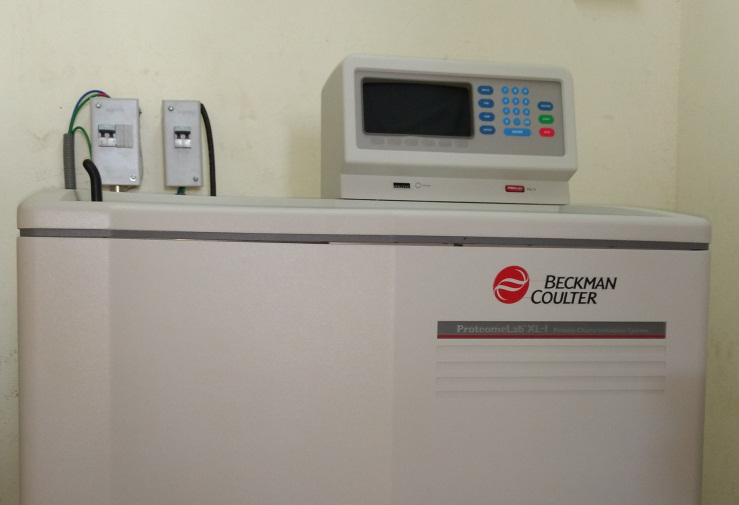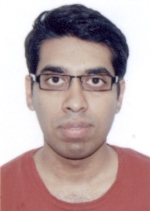- APPLY FOR SLOT
- Internal Users
- External Users
- SLOT BOOKING STATUS
Analytical Ultracentrifuge Lab

Phone : +91-3222-283306
Location : GF / Sir JC Bose Lab Complex), CRF
Facilitator :
Dr. Soumya De, School of Bio Science
Email: somde@iitkgp.ac.in, Contact:+91-3222-214552
For Internal Users - Click Here to apply for Slot
For External Users - Click Here to apply for Slot
Objectives
To measure the molecular weight and the hydrodynamic and thermodynamic properties of a protein or other macromolecule.
People

Dr. Soumya De
Facilitator
School of Bio Science
somde@iitkgp.ac.in
+91-3222-214552
Equipment Details
Analytical Ultracentrifuge
Name- Analytical Ultracentrifuge
Manufacturer- Beckman Coulter
Model- Proteomelab.XL-1
Year of Installation- 2017
Specifications
| Description | Specifications |
| Speed |
Set speed 1000 to 60,000 in increments of 100 rpm Speed control ±20 rpm of the set speed (above 1000 rpm) Speed display indicates rotor speed in increments of 10 rpm at speeds below 1000 rpm and 100 rpm at speeds above 1000 rpm |
| Time |
Set time Up to 999 hours and 59 minutes; HOLD for runs of unspecified length Time display Indicates time remaining in timed runs, time elapsed in HOLD runs, and estimated time remaining in ω2t runs |
| Temperature |
Set temperature 0 to 40 °C in 1°C increments Rotor temperature after equilibration ±0.5°C of set temperature Displayed rotor temperature after equilibration ±0.3°C of set temperature |
| Ambient temperature range | 15 to 30°C |
| ω2t integrator |
Calculate time for ω2t up to 9.99x1014 radians squared per second ω2t display shows the accumulated ω2t to three significant digits(in exponential notation) |
| Analytical acceleration | 5 to 400 rpm per second above 500 rpm;400 is maximum acceleration |
| Analytical deceleration | 5 to 400 rpm per second above 500 rpm;400 is maximum deceleration |
| XL acceleration | nine slow acceleration profiles from 0 to 500 rpm,maximum acceleration from 0 rpm to set speed |
| XL deceleration | nine slow deceleration profiles from set speed to 500 rpm, no brake, maximum deceleration from set speed to 0 rpm |
| Key switch | Used to select normal or locked operation; zonal operation not allowed |
| Instrument classification | T: uses Beckman Coulter analytical rotors only; preparative and zonal operation not allowed |
Analytical Specifications
Scanning UV/VIS Absorbance Optical System
| Description | Specifications |
| Wavelength range | 190 to 800 nm |
| Photometric display range | 0 to 3 absorption units |
| Scan steps |
Radial scan mode Up to 1650 data points per scan; radial increment step size 0.001 cm minimum,0.01 cm maximum Wavelength scan mode Up to 620 data points per scan; minimum wavelength increment step size 1.0 nm, maximum wavelength increment size 100 nm |
| Data rate |
One absorbance reading every 20 ms (approximately), depending on rotor speed |
| Replication/data averaging | 1 to 99 averages per data point |
| Concentration range | 5μg/ml-2mg/ml |
Interference optical System
| Description | Specifications |
| Wavelength | 660 nm |
| Camera resolution | 2048 x 96 pixels |
| Laser | 30 mW diode |
| Scan rate | Approx every 5 seconds |
| Interferometer precision | Approx ± 0.003 fringe |
| Concentration range | 25μg/ml-5mg/ml |
Name of the equipment: Analytical Ultracentrifuge
Physical data
| Description | Specifications |
| Weight |
Instrument only 465 kg |
| Height | (to top of control head)120.7 cm |
| Width | 94.0 cm |
| Depth | 67.3 cm |
| Ventilation clearances |
side 5.1 cm, rear 15.2 cm |
| Electrical supply | Class I (single phase,220/240V,50Hz) |
| Maximum heat dissipation into the room | 1.0 kW |
| Humidity restriction | Ë‚ 95 % (non condensing) |
| Noise level(measured 0.9 m or 3 ft in front of the instrument) | 57 dB |
| Installation (overvoltage) category | II |
| Pollution degree | 2a |
a. Normally only nonconductive pollution occurs; occasionally, however, a temporary conductivity caused by condensation must be expected.
Utility and Working Principal
The analytical ultracentrifuge is at present the most versatile, rigorous and accurate means for determining the molecular weight and the hydrodynamic and thermodynamic properties of a protein or other macromolecule. There is no other technique that is able to provide the same range of information with this precision and accuracy. This is because the method of sedimentation analysis is based on the sound platform of thermodynamics. All terms in the equation describing sedimentation behavior are experimentally determinable.
Many macromolecules including proteins have an inherent property to form aggregates which changes the molecular weight of the species formed, and analytical centrifugation provides valuable information regarding the molecular weight of the species. Analytical centrifugation can directly measure the molecular weights of solutes without having to rely on calibration or making assumptions concerning shape. It can detect a wide range of molecular weights ranging from small proteins to larger aggregates and also larger protein present in virus. Moreover the molecular weights of calibration standards used in electrophoresis prepared using sequencing techniques, for which analytical centrifugation are the best method.
Biomacromolecular recognition including its interactions with small molecules is an important part of bioscience. The sedimentation equilibrium methodology in the analytical ultracentrifuge is the only technique presently capable of analyzing such interactions over a wide range of solute concentrations, without interference in the chemical equilibrium. Weak interactions, in the order of 10-100 M-1 (association constant, Ka), cannot be studied using electrophoresis but can be effectively done with analytical centrifugation. Such interactions are also studied using absorbance, frequently by labeling with a chromophore. These can be easily studied using an analytical centrifuge.
Analytical ultracentrifuge is also a powerful technique for the characterization of nanomaterials, especially in the small size ranges (i.e., 1−10 nm). By centrifuging the particles at high centrifugal forces, it is possible to follow their concentration depletion profiles over time in order to determine the particle sedimentation coefficients, S. The small (1−10 nm) nanoparticles are the most difficult to detect but often the most biologically and environmentally relevant. Furthermore, the particle friction coefficient can also be determined in order to gain critical information on the particle form i.e. shape.
Detection mode - a) Built-in scanning UV/Visible b) Built-in Rayleigh interference optics
Sample holder - Preassembled cells for the two rotors: with sapphire window and/or quartz window
Sample Details
